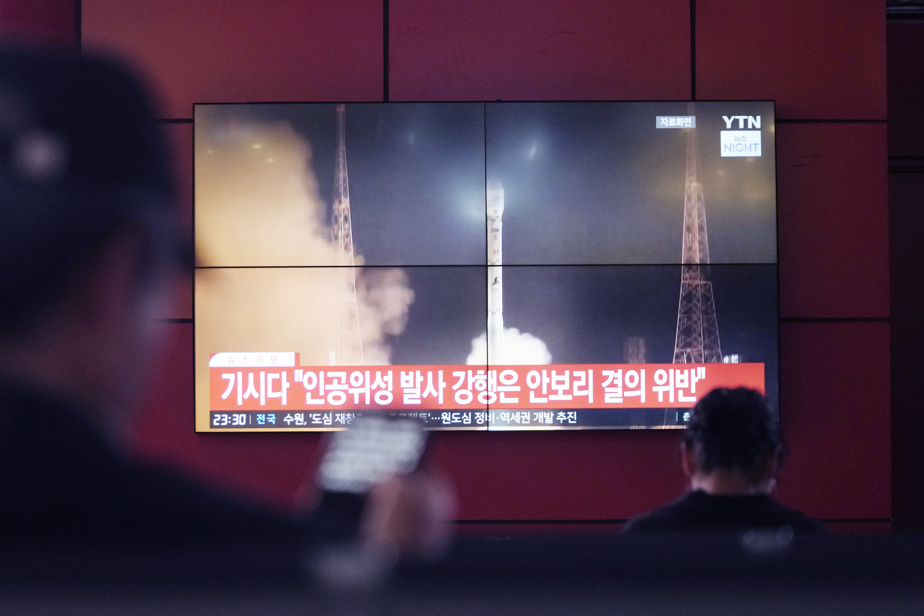(Seoul) Pyongyang announced Monday that it had tried in vain to put a spy satellite into orbit, the launcher having exploded in flight, a project that Seoul and Tokyo had strongly criticized a few hours earlier.
The launch vehicle for the Malligyong-1-1 reconnaissance satellite “exploded during the first phase of flight and failed,” the North Korean Aerospace Administration said in a statement carried by state media.
“The accident” is linked to a problem with the “reliability of the liquid oxygen and kerosene engine” of recent design, according to the same source.
Japanese public broadcaster NHK broadcast footage of what appeared to be a flaming projectile in the night sky, which then erupted into a ball of flames. The channel said it filmed it from northeast China at the time of the attempted launch.
Pyongyang informed Japan earlier on Monday that it planned to put a new satellite into orbit, following a successful attempt in November and two failures early last year.
“Our military detected around 10:44 p.m. (9:44 a.m. Eastern Time) Monday the trajectory of what is suspected to be a North military reconnaissance satellite fired from the Tongchang-ri area in Pyongan Province from the North, to the South,” the Seoul Joint Chiefs of Staff said.
But two minutes later, “numerous fragments of the projectile were detected in North Korean waters, and the United States and South Korea are analyzing” this debris, the staff said.
This launch “is a provocation that clearly violates the United Nations Security Council resolution prohibiting the use of ballistic missile technology,” he added.
Japan also confirmed the launch. Authorities there briefly issued an alert inviting residents of southern Okinawa Prefecture to take refuge in shelters. This alert was lifted after a few minutes.
Earlier on Monday, following a rare tripartite summit between South Korea, Japan and China, leaders in Seoul and Tokyo urged North Korea to cancel the announced launch of its satellite that will harm “regional and global peace and stability”.

PHOTO CHUNG SUNG-JUN, REUTERS
Japanese Prime Minister Fumio Kishida, South Korean President Yoon Suk Yeol and Chinese Prime Minister Li Qiang
Failed launches
The South Korean military conducted attack formation flight and strike training on Monday to demonstrate “the strong capabilities and will of our army” planned in response to North Korea’s announcement of its intention to launch a satellite by June 4.
Numerous United Nations resolutions prohibit nuclear-armed North Korea from testing ballistic technology, and analysts say there is significant technological overlap between launch capabilities in the space and the development of ballistic missiles.
Experts say spy satellites could improve Pyongyang’s intelligence-gathering capabilities, particularly against its arch-rival South Korea, and provide crucial data in the event of a military conflict.
The South Korean military said Friday that they suspected North Korea of soon wanting to launch a new military spy satellite.
Evidence of preparations for a satellite launch had been detected in North Korea’s Thongchang-ri county, home to the Sohae launch site.
According to Pyongyang, the satellite put into orbit in November notably provides images of American and South Korean military sites.
North Korea says the “Malligyong-1” satellite is working properly, but Seoul’s intelligence agency rejects the claim.
Seoul’s National Intelligence Service collected and analyzed debris from one of Pyongyang’s failed launches early last year, and concluded that it had no military use.
Seoul said Pyongyang received technical help from Russia for its satellite launch in November, in exchange for sending Moscow weapons used in the war in Ukraine.
Kim Jong-un met President Vladimir Putin in Russia last September, and Mr. Putin then suggested his country could help Pyongyang build satellites.
A group of Russian engineers entered North Korea to help prepare for the launch, Yonhap news agency said Sunday, citing a government official.
In December, Pyongyang indicated that it wanted to launch three additional spy satellites in 2024.
